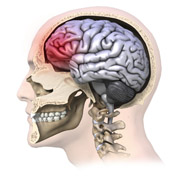Research and Innovation, UNL Office of

Center for Brain, Biology, and Behavior: Faculty Publications
Document Type
Article
Date of this Version
9-27-2017
Citation
Published in Brain Research 1677 (2017), pp 58–73.
doi 10.1016/j.brainres.2017.09.025
Abstract
Processing dynamic tactile inputs is a primary function of the somatosensory system. Spatial velocity encoding mechanisms by the nervous system are important for skilled movement production and may play a role in recovery of sensorimotor function following neurological insult. Little is known about tactile velocity encoding in mechanosensory trigeminal networks required for speech, suck, mastication, and facial gesture.
High resolution functional magnetic resonance imaging (fMRI) was used to investigate the neural substrates of velocity encoding in the human orofacial somatosensory system during unilateral saltatory pneumotactile stimulation of perioral and buccal hairy skin in 20 neurotypical adults. A custom multichannel, scalable pneumotactile array consisting of 7 TAC-Cells was used to present 5 stimulus conditions: 5 cm/s, 25 cm/s, 65 cm/s, ALL-ON synchronous activation, and ALL-OFF. The spatiotemporal organization of whole-brain blood oxygen level-dependent (BOLD) response was analyzed with general linear modeling (GLM) and fitted response estimates of percent signal change to compare activations associated with each velocity, and the main effect of velocity alone.
Sequential saltatory inputs to the right lower face produced localized BOLD responses in 6 key regions of interest (ROI) including; contralateral precentral and postcentral gyri, and ipsilateral precentral, superior temporal (STG), supramarginal gyri (SMG), and cerebellum. The spatiotemporal organization of the evoked BOLD response was highly dependent on velocity, with the greatest amplitude of BOLD signal change recorded during the 5 cm/s presentation in the contralateral hemisphere. Temporal analysis of BOLD response by velocity indicated rapid adaptation via a scalability of networks processing changing pneumotactile velocity cues.
Included in
Behavior and Behavior Mechanisms Commons, Nervous System Commons, Other Analytical, Diagnostic and Therapeutic Techniques and Equipment Commons, Other Neuroscience and Neurobiology Commons, Other Psychiatry and Psychology Commons, Rehabilitation and Therapy Commons, Sports Sciences Commons


Comments
Copyright © 2017 Elsevier B.V. Used by permission.